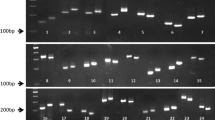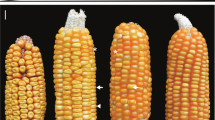Abstract
Quality protein maize (QPM) was created by selecting genetic modifiers that convert the starchy endosperm of an opaque2 (o2) mutant to a hard, vitreous phenotype. Genetic analysis has shown that there are multiple, unlinked o2 modifiers (Opm), but their identity and mode of action are unknown. Using two independently developed QPM lines, we mapped several major Opm QTLs to chromosomes 1, 7 and 9. A microarray hybridization performed with RNA obtained from true breeding o2 progeny with vitreous and opaque kernel phenotypes identified a small group of differentially expressed genes, some of which map at or near the Opm QTLs. Several of the genes are associated with ethylene and ABA signaling and suggest a potential linkage of o2 endosperm modification with programmed cell death.


Similar content being viewed by others
References
Belousov AA (1987) Genetic analysis of modified endosperm texture in opaque2 maize. Sov Genet 23:459–464
Bhan MK, Bhandari N, Bahl R (2003) Management of the severely malnourished child: perspective from developing countries. Br Med J 326:146–151
Bjarnason M, Vasal SK (1992) Breeding quality protein maize (QPM). Plant Breed 9:181–216
Coleman CE, Herman EM, Takasaki K, Larkins BA (1996) The maize γ-zein sequesters α-zein and stabilizes its accumulation in protein bodies of transgenic tobacco endosperm. Plant Cell 12:2335–2345
Coleman CE, Clore AM, Ranch JP, Higgins R, Lopes MA, Larkins BA. (1997) Expression of a mutant α-zein creates the floury2 phenotype in transgenic maize. Proc Natl Acad Sci USA 94:7094–7097
Dannenhoffer JM, Bostwick DE, Or E, Larkins BA (1995) opaque15, a novel mutation with properties of an opaque2 modifier. Proc Natl Acad Sci USA 92:1931–1935
Deutscher D (1978) The current status of breeding for protein quality in corn. In: Friedman M (ed) Nutritional improvement of food and feed grains. Plenum, New York, pp 281–300
Erasmus C, Taylor JRN (2004) Optimising the determination of maize endosperm vitreousness by a rapid non-destructive image analysis technique. J Sci Agric 84:920–930
Ewing B, Green P (1998) Base-calling of automated sequencer traces using phred II. Error probabilities. Genome Res 8:186–194
Ewing B, Hillier L, Wendl MC, Green P (1998) Base-calling of automated sequencer traces using phred I. Accuracy assessment. Genome Res 8:175–185
Geetha KB, Lending CR, Lopes MA, Wallace JC, Larkins BA (1991) opaque–2 modifiers increase gamma-zein synthesis and alter its distribution in maize endosperm. Plant Cell 3:1207–1219
Geevers HO, Lake JK (1992) Development of modified opaque-2 maize in South Africa. In: Mertz ET (ed) Quality protein maize. American Association of Cereal Chemists, St. Paul, MN, pp 49–78
Gibbon BC, Wang X, Larkins BA (2003) Altered starch structure is associated with endosperm modification in quality protein maize. Proc Nat Acad Sci USA 100:15329–15334
Giroux MJ, Boyer C, Feix G, Hannah LC (1994) Coordinated transcriptional regulation of storage product genes in maize endosperm. Plant Physiol 106:713–722
Gordon D, Abajian C, Green P (1998) Consed: a graphical tool for sequence finishing. Genome Res 8:195–202
Guo H, Ecker JR (2004) The ethylene signaling pathway: new insights. Curr Opin Plant Biol 7:40–49
Habben JE, Larkins BA (1995) Improving protein quality in seeds. In: Kijel J, Galili G (eds) Seed development and germination. Marcel Dekker, NY, pp 791–810
Hirayama T, Shinozaki K (2007) Perception and transduction of abscisic acid signals: keys to the function of the versatile plant hormone, ABA. Trends Plant Sci 12:343–351
Hochholdinger F, Hoecker N (2007) Towards the molecular basis for heterosis. Trends Plant Sci 12:427–432
Holding DR, Larkins BA (2006) The development and importance of zein protein bodies in maize endosperm. Maydica 51:243–254
Holding DR, Otegui M, Li B, Meeley RB, Dam T, Hunter BG, Jung R, Larkins BA (2007) The maize Floury1 gene encodes a novel ER protein involved in zein protein-body formation. Plant Cell 19:2569–2582
Hunter BG, Beatty MK, Singletary GW, Hamaker BR, Dilkes BP, Larkins BA, Jung R (2002) Maize opaque endosperm mutations create extensive changes in patterns of gene expression. Plant Cell 14:2591–2612
Kaufman RJ (1999) Stress signaling from the lumen of the endoplasmic reticulum: coordination of gene transcriptional and translational controls. Genes Dev 13:1211–1233
Kim CS, Hunter BG, Kraft J, Boston RS, Yans S, Jung R, Larkins BA (2004) A defective signal peptide in a 19-kD α-zein protein causes the unfolded protein response and an opaque endosperm phenotype in the maize De*-B30 mutant. Plant Physiol 134:380–387
Kim CS, Gibbon BC, Gillikin JW, Larkins BA, Boston RS, Jung R (2006) The maize Mucronate mutation is a deletion in the 16-kDa γ-zein gene that induces the unfolded protein response. Plant J 48:440–451
Kniep KR, Mason SC (1989) Kernel breakage and density of normal and opaque2 maize grain as influenced by irrigation and nitrogen. Crop Sci 29:158–163
Lawrence CJ, Schaeffer ML, Seigfried TE, Campbell DA, Harper LC (2007) MaizeGDB’s new data types, resources and activities. Nucleic Acids Res 35:D895–900
Li PX, Hardacre AK, Campanella OH, Kirkpatrick KJ (1996) Determination of endosperm characteristics of 38 corn hybrids using the Stenvert hardness test. Cereal Chem 73:466–471
Lending CR, Larkins BA (1989) A model for protein body formation in corn: immunolocalization of zeins in developing maize endosperm by light and electron microscopy. Plant Cell 1:1011–1023
Lopes MA, Larkins BA (1991) Gamma-zein content is related to endosperm modification in quality protein maize. Crop Sci 31:1655–1662
Lopes MA, Larkins BA (1995) Genetic analysis of opaque2 modifier gene activity in maize endosperm. Theor Appl Genet 19:274–281
Lopes MA, Takasaki K, Bostwick DE, Helentjaris T, Larkins BA (1995) Identification of two opaque2 modifier loci in quality-protein-maize. Mol Gen Genet 247:603–613
Manly KF, Cudmore RH Jr, Meer JM (2001) Map Manager QTX, cross-platform software for genetic mapping. Mamm Genome 12:930–932
Mertz ET (1992) Quality protein maize. American Association of Cereal Chemists, St. Paul, MN
Michelmore RW, Paran I, Keseli RV (1991) Identification of markers linked to disease-resistant genes by bulked segregant analysis: a rapid method to detect markers in specific genomic regions by using segregation populations. Proc Natl Acad Sci USA 88:9828–9832
Munck L (1992) The case of high-lysine barley breeding. In: Shewry P (ed) Barley, genetics, biochemistry, molecular biology and biotechnology. CAB International, Wallingford, pp 573–601
Nelson OE Jr, Rines HW (1962) The enzymatic deficiency in the waxy mutant of maize. Biochem Biophys Res Comm 9:297–300
Ortega EI, Bates LS (1983) Biochemical and agronomic studies of two modified hard-endosperm opaque2 maize (Zea mays L.) populations. Cereal Chem 60:107–111
Pingali PL (2001) CIMMYT 1999–2000 Facts and trends meeting world maize needs. Technological opportunities and priorities for the public sector. CIMMYT, Mexico City
Prasanna BM, Vasal SK, Kassahun B, Singh NN (2001) Quality protein maize. Curr Sci 81:1308–1319
Quarrie SA, Lazic-Jancic V, Kovacevic D, Steed A, Pekic S (1999) Bulk segregant analysis with molecular markers and its use for improving drought resistance in maize. J Exp Bot 50:1299–1306
Schmidt RJ (1993) Opaque2 and zein gene expression. In: Verma DPS (ed) Control of plant gene expression. CRC Press, Boca Raton, FL, pp 337–355
Segal G, Song R, Messing J (2003) A new opaque variant of maize by a single dominant RNAi-inducing transgene. Genetics 165:387–397
Séne M, Thévenot C, Hoffmann D, Bénétrix F, Causse M, Prioul J-L (2001) QTLs for grain dry milling properties, composition and vitreousness in maize recombinant inbred lines. Theor Appl Genet 102:591–599
Shen B, Carneiro N, Torresjerez I, Stevenson B, McCreery T, Helentjaris T, Baysdorfer C, Almira E, Ferl RJ, Habben JE, Larkins B (1994) Partial sequencing and mapping of clones from two maize cDNA libraries. Plant Mol Biol 26:1085–1101
Smalle J, Vierstra RD (2004) The ubiquitin 26S proteasome proteolytic pathway. Annu Rev Plant Biol 55:555–590
Sreenivasulu N, Radchuk V, Strickert M, Miersch O, Weschke W, Wobus U (2006) Gene expression patterns reveal tissue-specific signaling networks controlling programmed cell death and ABA-regulated maturation in developing barley seeds. Plant J 47:310–327
Tomkins JP, Davis G, Main D, Yim YS, Duru N, Muskat T, Goicoechea JL, Frisch DA, Coe EH Jr, Wing RA (2002) Construction and characterization of a deep-coverage bacterial artificial chromosome library for maize. Crop Sci 42:928–933
Tsai CY, Larkins BA, Glover DV (1978) Interaction of the opaque-2 gene with starch-forming mutant genes on the synthesis of zein in maize endosperm. Biochem Genet 16:883–896
Vasal SK, Villegas E, Bjarnason M, Gelaw B, Goertz P (1980) Genetic modifiers and breeding strategies in developing hard endosperm opaque2 materials. In: Pollmer WG, Phillips RH (eds) Quality traits of maize for grain and silage use. Martinus Nijhoff, London, pp 37–73
Vasil IK (1998) Biotechnology and food security for the 21st century: a real world perspective. Nat Biotech 16:399–400
Vieira J, Messing J (1982) The pUC plasmids, an M13mp7-derived system for insertion mutagenesis and sequencing with synthetic universal primers. Gene 19:259–268
Wallace JC, Lopes MA, Paiva E, Larkins BA (1990) New methods for extraction and quantification of zeins reveal a high content of gamma-zein in modified opaque-2 maize. Plant Physiol 92:191–196
Woo YM, Hu DWN, Larkins BA, Jung R (2001) Genomic analysis of genes expressed in maize endosperm identifies novel seed proteins and clarifies patterns of zein gene expression. Plant Cell 13:2297–2317
Yanagisawa S, Yoo SD, Sheen J (2003) Differential regulation of EIN3 stability by glucose and ethylene signaling in plants. Nature 425:521–525
Yim YS, Davis GL, Duru NA, Musket TA, Linton EW, Messing JW, McMullen MD, Soderlund CA, Polacco ML, Gardiner JM, Coe EH Jr (2002) Characterization of three maize bacterial artificial chromosome libraries toward anchoring of the physical map to the genetic map using high-density bacterial artificial chromosome filter hybridization. Plant Physiol 130:1686–1696
Young TE, Gallie DR (2000) Regulation of programmed cell death in maize endosperm by abscisic acid. Plant Mol Biol 42:397–414
Young TE, Gallie DR, DeMason DA (1997) Ethylene-mediated programmed cell death during maize endosperm development of wild type and shrunken2 genotypes. Plant Physiol 115:737–751
Young VR, Scrimshaw NS, Pellet PL (1998) Significance of dietary protein source in human nutrition: animal and/or plant proteins? In: Waterlow JC, Armstrong DG, Fowden L, Riley R (eds) Feeding a world population of more than eight billion people. Oxford University Press in associate with Rank Prize Funds, New York, pp 205–221
Acknowledgments
The research described in this manuscript was supported by grants from the USDA (CSREES 2004-35301-14537 to BAL) and DOE (# DE-FG05-95ER20194 to JM). We thank Roberto Lizzaraga-Guerra for creating the genetic materials that were used in this analysis, and acknowledge his contribution to the QTL marker analysis. The authors owe a special thanks to Dr. William Bickel in the Physics Department at the University of Arizona, who tested a variety of procedures for measuring kernel vitreousness, and to Max Feldman for technical support. Authors also thank Tim Helentjaris and John Klingler for reviewing and commenting on the manuscript.
Author information
Authors and Affiliations
Corresponding author
Additional information
Communicated by T. Lübberstedt.
Electronic supplementary material
Below is the link to the electronic supplementary material.
Rights and permissions
About this article
Cite this article
Holding, D.R., Hunter, B.G., Chung, T. et al. Genetic analysis of opaque2 modifier loci in quality protein maize. Theor Appl Genet 117, 157–170 (2008). https://doi.org/10.1007/s00122-008-0762-y
Received:
Accepted:
Published:
Issue Date:
DOI: https://doi.org/10.1007/s00122-008-0762-y




